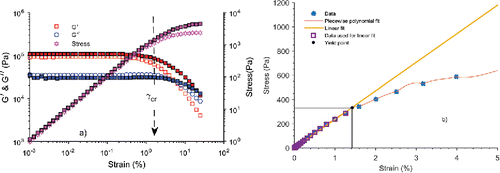ABSTRACT
Water is one of the most common contaminants in grease lubrication. There are numerous applications where bearings are susceptible to water ingresses such as in the steel, food, and pulp and paper industries. A grease can absorb water to different degrees depending upon the type of grease. The ability of a grease to either absorb or reject water can influence the service life of rolling bearings. Two parameters that determine the performance of a grease at very low temperature are the yield stress and startup torque. Water was found to influence the yield stress and startup torque depending on the operating temperature, grease type, and percentage water in the grease.
Introduction
The majority of rolling bearings are grease lubricated. The operational life of a rolling bearing is often determined by the performance of the grease or by the presence of contaminants such as water. Grease can absorb considerable quantities of water depending on its chemical composition (Leckner Citation(1); Cyriac, et al. Citation(2)). The absorption of a high concentration of water by a grease is mainly attributed to the polarity of its components (thickener, oil, and additives; Cyriac, et al. Citation(2)). In rolling bearings, the high consistency of grease acts as an additional sealant to prevent the entry of solid contaminants and water. However, there are applications (food, steel, paper, pulp industry, marine, etc.) where water could enter the bearing; for example, as a result of improper sealing. Ingress of water into the bearing may influence the grease lubrication mechanisms (Mistry Citation(3)). Water can also influence the service life of the bearings, which is determined by the fatigue life of the bearing and the life of the grease (Lugt Citation(4)). Water also has an impact on the performance of oil-lubricated contacts (Fatima, et al. Citation(5); Cantley Citation(6)). However, this falls outside the scope of the present article.
Water was shown to have a profound influence on the rheological properties of grease (Leckner Citation(1); Cyriac, et al. Citation(2)). Depending on the nature of the thickener, water can result in the formation of either a softer or stiffer grease matrix. A change in the rheological properties in the presence of water can influence grease lubricity (Leckner Citation(1)), oil bleed characteristics (Leckner Citation(1); Cyriac, et al. Citation(7)), elastohydrodynamic lubrication film formation, etc. (Cyriac, et al. Citation(7)). In addition, water can influence the torque characteristics of a bearing (Mistry Citation(3)). One important parameter that determines the suitability of using a given grease especially at low temperature is the startup torque. The stiffening or softening of grease was shown to be a function of the temperature, water concentration, and grease composition (Cyriac, et al. Citation(2)). Any possible stiffening or softening of grease in the presence of water may also influence its startup torque characteristics. Mistry Citation(3) studied the influence of water on torque characteristics of greases used in an aircraft wheel bearing application. However, his study is limited to a test temperature of −54°C. It was found in his study that greases based on bentonite (clay), lithium, and calcium give rise to a notable increase in the startup torque with water. On the other hand, water exerted less influence on the startup torque of a grease based on hectorite (clay).
In an earlier paper, the authors studied the impact of water on the rheological properties of six commercial greases under steady and dynamic shear. The same greases are employed in this study. The goal of the present study is to extend the scope of the previous work, by studying the impact of water on the yield stress using oscillatory strain sweep over a wider low-temperature range than that in Cyriac, et al. Citation(2). One of the criteria used for measuring the lowest temperature where a grease can be used safely is the maximum startup torque in a standardized bearing configuration. In the present article, the rheological measurements will be combined with such startup torque measurements.
Materials and methods
Six greases, with the most commonly used thickeners and base oils, are used in this study (). A homogenous mixture of grease and deionized water was obtained using an in-house-made grease worker (; Cyriac, et al. Citation(2)). The maximum weight percentage of water absorption by the greases was obtained by visualizing the samples for free water droplets with the naked eye and/or a confocal microscope.
Table 1. Characteristics of lubricating greases studied.
Figure 1. (a) In-house-made grease mixer (reproduced from Cyriac, et al. Citation(2)) (b) Bearing startup torque measurement setup (reproduced from Cyriac, et al. Citation(10)).
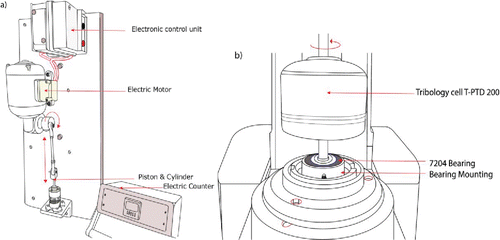
Tapping-mode atomic force microscopy (AFM) measurements of water-contaminated and uncontaminated grease samples were obtained using a Multimode 8 AFM (Bruker Nano Surfaces, Santa Barbara, CA) with a Nanoscope V controller (Cyriac, et al. Citation(8)). No significant difference in microstructure can be seen for the greases with and without water (). Because it was not possible to obtain a good quality image for the polyurea grease with 80% water, the result obtained with 60% water is shown in .
Figure 2. AFM images obtained for water-contaminated and uncontaminated grease samples with thickener particle dimensions.
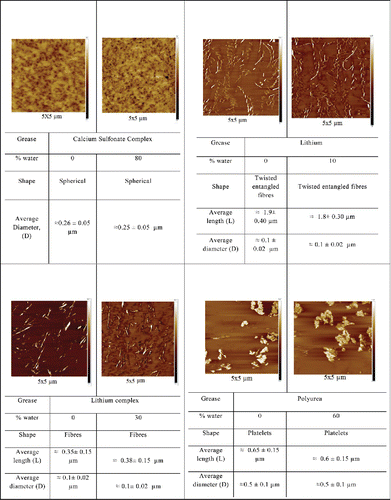
Oscillatory strain sweep measurements
Oscillatory strain sweep measurements were performed using an Anton Paar rheometer-MCR 501. These measurements were performed using a sandblasted parallel plate geometry (Ra ≈ 2.87 µm, D = 25 mm and 1 mm gap) and the greases were characterized in a range of strain from 0.001 to 1,000% at a frequency of 1 Hz. After loading the grease samples, a relaxation time of 20 min, which was found to be sufficient to relieve the residual stresses, was employed before performing the measurements. The measurements were performed in a temperature window of −50 to 50°C with a precision of ±0.5°C.
Startup torque measurements
The startup torque measurements of water-contaminated and uncontaminated grease samples were performed in the same rheometer but with tribology cell T-PTD 200 ().
The startup torque measurements were performed using the IP 186 standard testing procedure using an axially loaded angular contact ball bearing (SKF 7204 BEP). The amount of grease contained in the bearing (in grams) is taken as the product of grease density () and 2.6 ± 0.1 ml of grease. After loading the required quantity of grease as per the standard, preshearing was performed using oscillatory strain sweep and the test conditions are shown in .
Table 2. Test conditions employed for preshearing the grease samples.
After preshearing the grease sample, startup torque measurements were performed in a temperature window of −18.75 to 50°C with a precision of ±0.1°C. The measurements were performed for 60 s after imposing a relaxation time of 20 min after preshearing.
Results
Yield stress from oscillatory strain sweep
The viscoelastic behavior of greases at a given frequency can be characterized by the storage modulus and loss modulus, which respectively characterize the solid- and liquid-like responses to an imposed deformation. The structural integrity of the sample is maintained below a critical strain amplitude (), where the material parameters (G′ and G″) are found to be independent of the imposed strain. However, with increasing deformation, the incremental strain disrupts the structural integrity of the sample, manifested by a decrease in elasticity (). Because there is no sharp transition from solid-like to liquid-like behavior, the yield stress is defined as the stress corresponding to a deviation of 0.5% from the linearity of the stress–strain relationship (Cyriac, et al. Citation(9); ). Because the accurate prediction of yield stress is a definite factor in the design and optimization of tribological systems, the yield stress obtained from an oscillatory measurement is preferred because it was previously shown to be less sensitive to measurement geometry compared to other methods (Cyriac, et al. Citation(9)).
Temperature dependency of yield stress
The variation in yield stress with temperature for the different greases is shown in . The yield stress for both water-contaminated and uncontaminated greases was found to vary exponentially with temperature. The variation in yield stress with temperature is fitted using an Arrhenius-type equation. The equation reads[1] where
is the yield stress at temperature T =
.
Figure 4. Yield stress from oscillatory strain sweep for water-contaminated and uncontaminated grease samples. The breakpoint is shown as the intersection of straight lines. For clarity, only one fitting curve is shown in the plot.
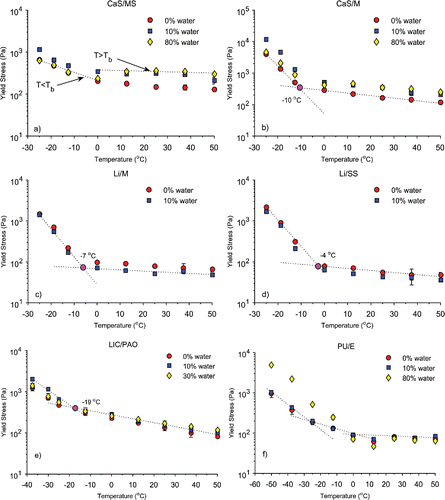
A significant deviation from Arrhenius behavior is exhibited by the studied greases when cooled below a certain temperature defined as the breakpoint temperature, . It was shown previously that the break in their relationship was related to the pour point of the base oil (Cyriac, et al. Citation(10)). Below this temperature, a second exponential constant was found to apply, where the sensitivity of yield stress to temperature was found to be significantly higher than the temperature above the breakpoint. The breakpoint temperature and parameter b obtained using Eq. [Equation1
[1] ] are listed in , respectively.
Table 3. Breakpoint temperature from yield stress and starting torque plots (values in parentheses) for water-contaminated and uncontaminated greases.
Table 4. Fitting parameter obtained from yield stress and starting torque plots (values in parentheses) using Eq. [Equation1
[1] ] for water-contaminated and uncontaminated greases.
The yield stress of calcium sulfonate complex greases increased with water, which is in agreement with the findings of Leckner Citation(1). However, at lower temperatures (0°C and below) the yield stress of calcium sulfonate complex greases (CaS/M and CaS/MS) with the maximum weight percentage of water was found to be lower than that of greases with 10% water. In addition, a higher concentration of water in CaS/MS was found to modify its breakpoint value. Similar to its uncontaminated counterpart, the relationship between yield stress and temperature is characterized by two independent straight lines. However, the transition to a higher energy state for CaS/M grease with 80% water is characterized by an intersecting discontinuity that cannot be associated to the solidification of base oil or water.
In contrast to calcium sulfonate complex greases, the yield stress of lithium greases was found to decrease with water content. No significant difference in yield stress was exhibited by lithium complex grease with 0 and 10% water. However, a higher concentration of water was found to slightly enhance its soft-solid rigidity. Similar to calcium sulfonate greases, the increased resistance to shear deformation of lithium complex grease with maximum percentage of water was found to be limited to a temperature of 0°C. At 0°C and below, the yield stress of LiC/PAO with 30% water was found to be comparable to that of their uncontaminated counterpart. Unlike other greases, the yield stress of water-contaminated and uncontaminated polyurea grease was found to be nonsensitive to temperature for measurements performed at 0°C and above. In addition, a substantial increase in yield stress is observed for this grease with 80% water. Because it was not possible to capture the variation in yield stress with temperature using two independent straight lines for this grease, it was excluded from the fitting.
Torque versus time
A typical evolution of torque versus time is shown in for two greases with and without water. The impact of water on torque characteristics is evident from . In the following section, only the startup torque will be discussed.
Startup torque versus temperature
The startup torque versus temperature for water-contaminated and uncontaminated greases is shown in . The effect of water on the startup torque differed with the greases studied. The startup torque of calcium sulfonate complex greases with 10% water was found to be comparable to that of its uncontaminated counterpart. However, a marginal increase in startup torque can be seen for these greases with 80% water. Similar to calcium sulfonate greases, no significant difference in startup torque can be seen for lithium complex and polyurea greases with 0 and 10% water. However, the same greases exhibited an increase in startup torque with the maximum weight percentage of water. In addition, a substantial increase in startup torque can be seen for polyurea grease with 80% water at 0°C and below. However, contrary to other greases studied, lithium greases showed a decrease in startup torque with water.
Figure 6. Startup torque versus temperature for the greases with and without water. The breakpoint is given as the intersection of two straight lines. For clarity, only a few fitting curves are shown.
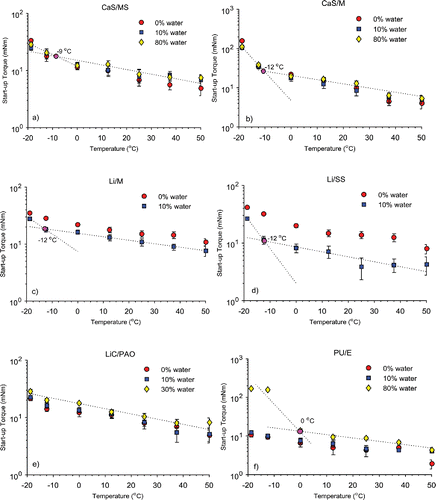
The variation in startup torque with temperature can be well fitted using Eq. [Equation1[1] ]. The startup torque was found to depend exponentially on temperature. However, similar to yield stress, a deviation from Arrhenius behavior characterized by a break was exhibited by the startup torque at low temperatures. The breakpoint and fitting parameter
obtained using Eq. [Equation1
[1] ] are listed in , respectively. The break for PAO- and ester oil–based greases probably occurs at a temperature lower than −18°C.
Discussion
The greases were found to absorb considerable quantities of water, which can be mostly attributed to the polar thickeners and additives present (Cyriac, et al. Citation(2)). Depending on the nature of the thickener, water was found to either enhance or reduce the yield stress and frictional startup torque. The increased flow resistance of calcium sulfonate complex greases in the presence of water is mainly attributed to agglomeration of the micelles (Giasson, et al. Citation(11)). It is most likely that a layer of water is formed around the calcium carbonate core, which then plays a vital role in increasing its stiffness. However, a high concentration of water in these greases at 0°C and below was found to reduce the dispersion stiffness. The decrease in yield stress for lithium greases must be caused by a reduction in particle interactive forces in the presence of water. Similar to calcium sulfonate complex greases, a higher concentration of water in LiC/PAO resulted in a decrease in yield stress below subzero temperatures, which again can be attributed to a decrease in dispersion stiffness due to freezing and expansion of water molecules. On the contrary, a higher concentration of water in polyurea grease below 0°C was found to enhance its yield stress. It is most likely that free water might have formed during the loading of polyurea grease with 80% water. This might have resulted in the formation of ice crystals, leading to a significant increase in yield strength.
For a grease-lubricated bearing, the startup torque is as a result of friction at the contact points and the frictional torque due to drag forces. By taking into account the load, boundary coefficient of friction, material property, and internal geometry of the bearing (Bhushan Citation(12)), the contribution of the drag forces to the startup torque was found to vary between 85 and 95%. During startup there will not be an elastohydrodynamic lubrication film and it can therefore be assumed that the temperature does not significantly influence the torque at the contact. The frictional starting resistance of a grease-lubricated bearing can therefore be mainly attributed to the drag forces. The startup torque is related to the shear stress experienced by the grease and is related to the yield stress during startup (Wikström and Höglund Citation(13); Thelen, et al. Citation(14); Kobzova, et al. Citation(15)). Because yield stress and startup torque are related, a change in yield stress (increase or decrease) is expected to be reflected on the startup torque characteristics as well. As expected, the change in rheological properties was found to have an influence on the startup torque of the greases studied. However, some discrepancies could also be seen, especially in the case of polyurea grease. The startup torque of polyurea grease was found to decrease exponentially with temperature, whereas the yield stress was found to be insensitive to temperature variations at temperatures above 0°C. An increase in startup torque for calcium sulfonate complex greases with the maximum weight percentage of water can be attributed to their increased flow resistance. However, an increase in yield stress observed for these greases with 10% water was not found to have a significant influence on their startup frictional torque. Therefore, it is most likely that there is a threshold in yield stress (function of grease type) that should be achieved to observe a notable difference in the startup torque.
In an earlier paper (Cyriac, et al. Citation(10)), the breakpoint was shown to be related to the pour point of the base oil. The present study shows that the breakpoint is unaffected by water with the exception of CaS/MS grease with 80% water. The reason for this anomaly is not well understood. At 0°C and subzero temperatures, the emulsified water is expected to form ice crystals. However, this was not found to have any influence on the breakpoint of the greases. However, for polyurea grease with 80% water, the break in the Arrhenius plot was found to occur at temperatures close to the freezing point of water. Water might have separated from this grease during the running in, resulting in free water. This might have resulted in a frictional resistance an order of magnitude higher compared to the startup torque with 0% and 10% water. Therefore, it can be concluded that emulsified water is less harmful that the entrapped water when a bearing is subjected to startup at subzero temperatures.
Conclusions
The studied greases were found to absorb considerable quantities of water depending on the nature of the thickener. The yield stress and startup torque of uncontaminated and water-contaminated greases exhibited Arrhenius behavior but with different exponents at low and high temperatures. The breakpoint temperature, which was related to the pour point of the base oil, was not influenced by water. However, the breakpoint can be influenced by free water crystals at the vicinity of the contact, resulting in higher frictional resistance at subzero temperatures. Small quantities of water (≤10%) do not have any influence on the startup torque of calcium sulfonate complex, lithium complex, and polyurea greases. However, an increase in startup torque can be seen for these greases with the maximum weight percentage of water. On the contrary, a decrease in startup torque is exhibited by greases based on lithium as a thickener. The difference in torque response of the greases can be attributed to their yield stress, which was also found to be influenced by water.
Acknowledgements
The authors thank SKF Engineering & Research Centre, Nieuwegein, The Netherlands, for providing the grease samples, as well as technical and financial support, and Clemens Padberg from the University of Twente for the AFM measurements. This research was carried out under project number M21.1.12457 in the framework of the Research Program of the Materials innovation institute M2i (www.m2i.nl).
References
- Leckner, J. (2013), “Water + Grease = Fatal Attraction?” 25th ELGI Annual General Meeting, 20–23 April, Amsterdam, The Netherlands.
- Cyriac, F., Lugt, P. M., and Bosman, R. (2015), “Impact of Water on the Rheology of Lubricating Greases,” Tribology Transactions, 59(4), 679–689.
- Mistry, A. (2005), “Performance of Lubricating Greases in the Presence of Water,” NLGI Spokesman, 68(12), pp 8–15.
- Lugt, P. M. (2009), “A Review on Grease Lubrication in Rolling Bearings,” Tribology Transactions, 52(4), pp 470–480.
- Fatima, N., Marklund, P., Mathew, A. P., and Larsson, R. (2016), “Wet Clutch Friction Interfaces under Water-Contaminated Lubricant Conditions,” Tribology Transactions, 59(3), pp 441–450.
- Cantley, R. E. (1977), “The Effect of Water in Lubricating Oil on Bearing Fatigue Life,” ASLE Transactions, 20(3), pp 244–248.
- Cyriac, F., Lugt, P. M., Bosman, R., and Venner, C. H. (2016), “Impact of Water on EHL Film Thickness of Lubricating Greases in Rolling Point Contact,” Tribology Letters, 61(3), pp 1–8.
- Cyriac, F., Lugt, P. M., Bosman, R., Padberg, C. J., and Venner, C. H. (2016), “Effect of Thickener Particle Geometry and Concentration on the Grease EHL Film Thickness at Medium Speeds,” Tribology Letters, 61(2), pp 1–13.
- Cyriac, F., Lugt, P. M., and Bosman, R. (2015), “On a New Method to Determine the Yield Stress in Lubricating Grease,” Tribology Transactions, 58(6), pp 1021–1030.
- Cyriac, F., Lugt, P. M., and Bosman, R. (2016), “Yield Stress and Low Temperature Start-Up Torque of Lubricating Greases,” Tribology Letters, 63(1), pp 1–10.
- Giasson, S., Espinat, D., and Palermo, T. (1993), “Study of Microstructural Transformation of Over Based Calcium Sulphonates during Friction,” Lubrication Science, 5(2), pp 91–111.
- Bhushan, B. (2000), “Rolling Element Bearings,” Modern Tribology Handbook, pp 1041–1083, London, UK: CRC Press.
- Wikström, V. and Höglund, E. (1996), “Starting and Steady-State Friction Torque of Grease-Lubricated Rolling Element Bearings at Low Temperatures—Part I: A Parameter Study,” Tribology Transactions, 39(3), pp 517–526.
- Thelen, E., Devine, M. J., and Stalling, L. J. (1971), “Starting Torques and Rheology of Lubricating Greases at Low Temperature,” Lubrication Engineering, 27(9), pp 305–310.
- Kobzova, R. I., Klimov, K. I., and Shul'zhenko, I. V. (1974), “Influence of Temperature on Static Frictional Torque of Grease-Lubricated Bearings,” Chemistry and Technology of Fuels and Oils, 10(3), pp 227–229.

